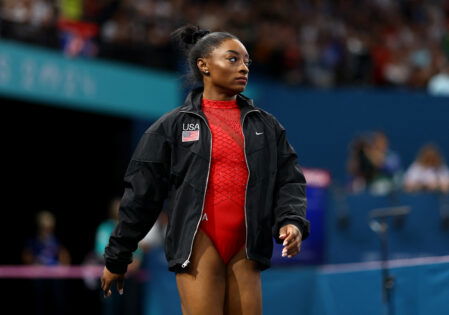Simone Biles has recently been reflecting on the vaults that shaped her rise, a reminder that even the sport’s most decorated gymnast looks back at the early building blocks of her career. That reflection adds fresh perspective to the 2021 U.S. Olympic Trials, when she once again confirmed her supremacy on the national stage.
In St. Louis, Biles delivered a combined 118.098 points across two days of competition, placing her more than two points clear of Sunisa Lee. On opening night, she posted 60.565, highlighted by a 15.133 on balance beam that featured her double-double dismount. She held back the Yurchenko double-pike vault she had recently debuted, but still secured the best vault totals of the field. Despite small errors on uneven bars and beam during the final session, she remained firmly in command, taking first on vault, beam, and floor, and third on bars. Her margin of 2.266 points underscored the gap between her and the rest of the roster.
That dominance resurfaced in conversation recently when Biles shared an old clip of herself performing the Amanar vault, a move she had long mastered with precision. A gymnastics enthusiast posted a short clip from the telecasted video from NBC where Biles can be spotted performing the move at the 2021 Trials. The fan captioned it, “Make Amanars Popular Again.” Simone Biles took no time to go down the memory lane. She immediately reposted the video on her X account with the words, “me amanar my faavvvv.” The exchange brought attention back to a vault that has defined multiple generations of gymnasts and remains a hallmark of Biles’s repertoire.
The Amanar, named after Romanian Olympic champion Simona Amânar, is a Yurchenko vault with two and a half twists in a laid-out position. It was once valued at 6.5 in the Code of Points and now carries 5.4, reflecting its difficulty and risk. Many gymnasts have hesitated to attempt it, yet Biles has delivered it with force and accuracy. At the trials, her vault scores of 15.466 and 15.400 combined for 30.866, a clear indication of her technical command.
me amanar
my faavvvv https://t.co/CQPIhjB1Iq
— Simone Biles (@Simone_Biles) August 18, 2025
Her choice to revisit the vault through that video shows how memory and performance intersect. At 28, Biles connects her present dominance with her early promise, pointing to the Amanar as both a personal favorite and a marker of her evolution. The 2021 trials secured her Olympic berth, but they also revealed how the foundation of her success, skills like the Amanar, continues to shape her legacy.
But unfortunately, the following Olympics, aka Tokyo Olympics in 2021, turned out to be a dark chapter in her life as she had to back off, succumbing to ‘twisties’. But she made sure to make the comeback in her Paris Redemption tour like a queen, to claim her status of being the gymnastics GOAT. However, this wasn’t the only time Simone performed her favorite skill in the arena. Simone Biles’s career has been profoundly shaped by her complex history with the Amanar vault.
Simone Biles and the Enduring Story of Her Amanar Vault
Simone Biles’ association with the Amanar vault is as intricate as it is unforgettable. First introduced into her competitive program in 2013, she executed the difficult round-off entry with 2½ twists in layout position with both height and precision. For years the vault was one of her signatures, a technical element that few could perform with such consistency. Yet the same vault that once underlined her supremacy later stood at the center of one of the most public struggles of her career.
Paris 2024 Olympics – Artistic Gymnastics – Women’s Vault Final – Bercy Arena, Paris, France – August 03, 2024. Simone Biles of United States in action. REUTERS/Mike Blake
At the Tokyo Olympics, the Amanar was intended to open the United States’ team final. In warm-ups, Biles altered her rotation mid-air, completing only 1½ twists. In competition, the same thing occurred, but with less lift, forcing her to step forward heavily upon landing.
A Yurchenko with 1½ twists holds far less value than an Amanar, and her score of 13.766 placed the team at an unexpected disadvantage. What became known as the “twisties” left her unable to trust her spatial awareness, and the attempt became a defining moment in the discussion of mental health within sport. The vault that had once embodied her power temporarily exposed the precarious line between risk and mastery.
Her story with the skill did not end in Tokyo. By Paris 2024, she had already added the far more demanding Yurchenko double pike, designated the “Biles II,” to her repertoire, a vault that carries a difficulty nearly unmatched. The Amanar remained part of her competitive narrative, but it was now accompanied by proof of her ability to progress even further.
In a period when many federations abandoned the Amanar due to reduced difficulty value and safety concerns, Simone Biles had already established her command of vaulting at the highest level, both by enduring its most daunting challenge and by redefining what could be attempted in international competition.
The post Simone Biles Faces Haunting Reminder of Gymnastics Milestone That Later Led to Darkest Year appeared first on EssentiallySports.
